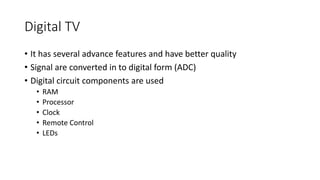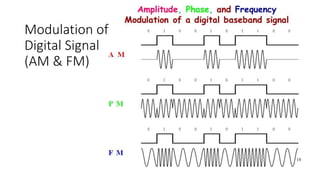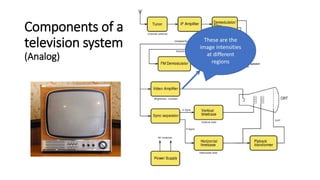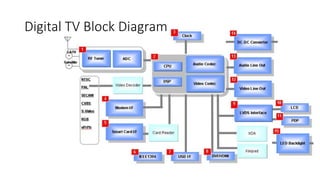TV (Television) A Brief Depiction of the internal Mechanism
- 1. Television (An Insight) Presented By: Hafiz Farhan
- 2. Types of TV ? There are two type of TV ? Analog Televisions ? Used in the old day ? Limited functionality ? Low cost ? Low resolutions ? Digital Televisions ? TV of modern era with diverse features ? Multitasking ? Similar cost ? High quality
- 3. Analog TV ? analog circuit components ? Signal were processed in analog form ? e.g.: ? Picture Tube ? Filters ? Antenna ? Controls
- 4. Digital TV ? It has several advance features and have better quality ? Signal are converted in to digital form (ADC) ? Digital circuit components are used ? RAM ? Processor ? Clock ? Remote Control ? LEDs
- 5. Protocols ? There are certain standards which are followed such as ? Video (MPEG, MP4, HDTV, etc.) ? Audio (MP3, etc.) ? Modulation ? Amplitude Modulation ? Frequency Modulation ? Phase Shift Modulation ? etc. ? Compression & Decompression ? Encoding & Decoding ? Others
- 6. 6 Monochrome TV Signals (NTSC) ? In the NTSC monochrome system the luminance signal is AM/VSB (Amplitude Modulation/Vestigial Sideband) modulated onto the video carrier ? The sound signal is FM modulated onto the Audio Sub-Carrier located 4.5 MHz from the video carrier 0 4.5 MHz Video Signal Audio Signal Video Carrier Audio Sub-Carrier
- 7. Signal Receiving ? First step is to receive the signals ? There are various methods to receive the signals ? Wireless ? Antenna ? Dish Antenna ? Wifi e.g. Wi-Tribe ? Wired ? Cable ? Internet (IP) e.g. PTCL Smart TV
- 8. Modulation of Analog Signal (AM & FM)
- 9. Modulation of Digital Signal (AM & FM)
- 10. Note ? So we can see that both Signals are received in analog form
- 11. Components of a television system (Analog)
- 12. Components of a television system (Analog)
- 13. Components of a television system (Analog)
- 14. Components of a television system (Analog)
- 15. Components of a television system (Analog)
- 16. Components of a television system (Analog)
- 17. Components of a television system (Analog)
- 18. Components of a television system (Analog)
- 19. Components of a television system (Analog)
- 20. Components of a television system (Analog)
- 21. Components of a television system (Analog)
- 22. Components of a television system (Analog) These are the image intensities at different regions
- 23. Components of a television system (Analog) These signals act as coordinates signal for the image
- 24. Analog TV (CRT / Picture Tube) Design of circuits, protocols and formats may vary country wise
- 25. Thus, a ˇ°composite video signalˇ± contains: 1. Intensity information 2. Horizontal retrace 3. Vertical retrace
- 26. Digital TV (LEDs, LCDs) Basic Block Diagram of Digital TV
- 27. Digital TV (Block Diagram)
- 28. Digital TV Block Diagram
- 29. Comparisons ? Digital TVs can store data where as analog cannot do so ? Digital TV consume less power than the other ? Digital TV Provide High Quality ? Heavy signal processing is required in digital TVs as compared to analog TVs





























